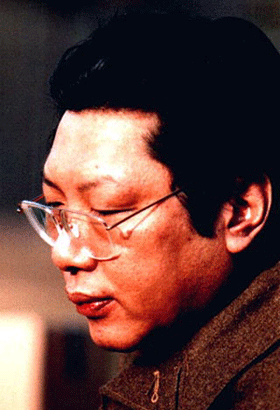 Chögyam Trungpa Rinpoche was a Buddhist meditation master and holder of both the Kagyu and Nyingma lineages, the eleventh Trungpa tülku, a tertön, supreme abbot of the Surmang monasteries, scholar, teacher, poet, artist, and originator of a radical re-presentation of Shambhala vision.
Chögyam Trungpa Rinpoche was a Buddhist meditation master and holder of both the Kagyu and Nyingma lineages, the eleventh Trungpa tülku, a tertön, supreme abbot of the Surmang monasteries, scholar, teacher, poet, artist, and originator of a radical re-presentation of Shambhala vision.
Recognized both by Tibetan Buddhists and by other spiritual practitioners and scholars as a preeminent teacher of Tibetan Buddhism, he was a major, albeit controversial, figure in the dissemination of Tibetan Buddhism to the West, founding Vajradhatu and Naropa University and establishing the Shambhala Training method.
Among his contributions are the translation of a large number of Tibetan texts, the introduction of the Vajrayana teachings to the West, and a presentation of the Buddhadharma largely devoid of ethnic trappings. Regarded as a mahasiddha by many senior lamas, he is seen as having embodied the crazy wisdom (Tib. yeshe chölwa) tradition of Tibetan Buddhism, his spiritual legacy. His occasionally unorthodox teaching methods and his un-monastic personal habits were the topic of controversy during his lifetime and afterwards.
Trungpa was one of the first teachers to introduce the esoteric practice of the Vajrayana to the West. According to Khenpo Tsultrim Gyamtso, “The one who mainly spread the Vajrayana in the West was Trungpa Rinpoche.” In contrast to its traditional presentation in Tibet, where the esoteric practices are largely the domain of the monastic sangha, in America Trungpa introduced the Vajrayana to the lay sangha.
The presentation of these teachings gave rise to some criticism. According to a former student, Stephen Butterfield, “Trungpa told us that if we ever tried to leave the Vajrayana, we would suffer unbearable, subtle, continuous anguish, and disasters would pursue us like furies” Other Vajrayana teachers, however, also warn their students about the dangers of the esoteric path.
Butterfield noted “disquieting resemblances” to cults, and “to be part of Trungpa’s inner circle, you had to take a vow never to reveal or even discuss some of the things he did.” However, Butterfield also notes that “This personal secrecy is common with gurus, especially in Vajrayana Buddhism,” and acknowledges that Trungpa’s organization is anything but a cult: “a mere cult leaves you disgusted and disillusioned, wondering how you could have been a fool. I did not feel that charlatans had hoodwinked me into giving up my powers to enhance theirs. On the contrary, mine were unveiled.”
In 1976, Trungpa began giving a series of secular teachings, some of which were gathered and presented as the Shambhala Training, inspired by his vision of the legendary Kingdom of Shambhala. Trungpa had actually started writing about Shambhala before his 1959 escape from Tibet to India, but most of those writings were lost during the escape.
In his view not only was individual enlightenment not mythical, but Shambhala Kingdom referred to an enlightened society that could in fact be actualized. The practice of Shambhala vision is to use mindfulness/awareness meditation as a way to connect with one’s basic goodness and confidence. It is presented as a path that “brings dignity, confidence, and wisdom to every facet of life.” The enlightened society it proposes would be led by himself as sakyong and his wife as queen-consort or sakyong wangmo.
Shambhala vision is described as a non-religious approach, rooted in meditation and accessible to individuals of any, or no, religion. In Shambhala terms, it is possible, moment by moment, for individuals to establish enlightened society. His book, Shambhala: The Sacred Path of the Warrior, provides a concise collection of the Shambhala views. According to Trungpa, it was his intention to propagate the kingdom of Shambala that provided the necessary inspiration to leave his homeland and make the arduous journey to India and the West.
Upon the death of Chögyam Trungpa, the leadership of Vajradhatu was first carried on by his American disciple, appointed regent and Dharma heir, Ösel Tendzin (Thomas Rich), and then by Trungpa’s eldest son and Shambhala heir, Sakyong Mipham Rinpoche.




